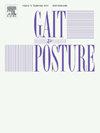步态异常和能力改变儿童特发性脚趾行走轻/中度小腿挛缩
IF 2.4
3区 医学
Q3 NEUROSCIENCES
引用次数: 0
摘要
特发性脚趾行走是一种常见的儿科疾病,那些在童年以后继续用脚趾行走的人被描述为患有持续性特发性脚趾行走(ITWp)。患有ITWp和轻度/中度挛缩的儿童可能能够将他们的步态模式改变为更典型的步态。本研究的目的是比较ITWp和轻度/中度腓肠肌/比目鱼肌挛缩儿童的自我选择脚趾步行和“最佳步行”模式。方法本前瞻性多地点研究招募了6-18岁的ITWp患儿,并进行了身体检查,膝关节从10°跖屈延伸到5°背屈。收集多节段足模型的下肢运动学数据,进行自选和最佳步行试验,以及动力学和肌电图。比较了自选步行ITWp、最佳步行ITWp和年龄匹配的典型发展队列之间的变量。结果65名儿童参与本研究。自我选择步行后,后脚和前脚都增加了跖屈。尽管有轻度/中度挛缩,但这组患者可以通过整体背屈,自愿改变他们的步态模式,从自我选择到最佳步行,从而改善后脚和前脚的运动学和踝关节动力学。这些改变导致了总结指标的改善,并要求更高水平的运动控制。此外,50% %的肢体在最佳行走状态下达到了第一个摇杆。结论ITWp和轻度/中度跖屈肌挛缩的儿童能够自主地改变其步态模式,使其更倾向于平足模式。即使是平脚行走,与典型发育步态的偏差仍然存在。本文章由计算机程序翻译,如有差异,请以英文原文为准。
Gait abnormalities and ability to alter gait in children with idiopathic toe walking with a mild/moderate calf contracture
Background
Idiopathic toe walking is a common pediatric condition with those who continue to walk on their toes beyond childhood described as having persistent idiopathic toe walking (ITWp). Children with ITWp and mild/moderate contractures might be able to alter their gait pattern to a more typical gait. The purpose of this study was to compare self-selected toe walking to a “best-walk” pattern for children with ITWp and mild/moderate gastrocnemius/soleus contractures.
Methods
This prospective multi-site study recruited children with ITWp, aged 6–18 years, and physical exam dorsiflexion with knee extended from 10° plantarflexion to 5° dorsiflexion. Lower extremity kinematics with a multi-segment foot model were collected for self-selected and best-walk trials along with kinetics and electromyography. Variables were compared between conditions of self-selected walking ITWp, best-walk ITWp, and an age matched typically developing cohort.
Results
Sixty-five children participated in this study. Both the hindfoot and forefoot had increased plantarflexion with self-selected walking. Despite having a mild/moderate contracture, this group could volitionally alter their gait pattern from self-selected to best-walk via overall dorsiflexion, resulting in improvements in hindfoot and forefoot kinematics, and ankle kinetics. These alterations led to improved summary metrics and required higher levels of motor control. Additionally, 50 % of the limbs achieved a first rocker in the best-walk condition.
Conclusion
Children with ITWp and a mild/moderate plantarflexor contracture were able to volitionally alter their gait pattern to a more foot flat pattern. Deviations from typically developing gait remained even with foot flat walking.
求助全文
通过发布文献求助,成功后即可免费获取论文全文。
去求助
来源期刊

Gait & posture
医学-神经科学
CiteScore
4.70
自引率
12.50%
发文量
616
审稿时长
6 months
期刊介绍:
Gait & Posture is a vehicle for the publication of up-to-date basic and clinical research on all aspects of locomotion and balance.
The topics covered include: Techniques for the measurement of gait and posture, and the standardization of results presentation; Studies of normal and pathological gait; Treatment of gait and postural abnormalities; Biomechanical and theoretical approaches to gait and posture; Mathematical models of joint and muscle mechanics; Neurological and musculoskeletal function in gait and posture; The evolution of upright posture and bipedal locomotion; Adaptations of carrying loads, walking on uneven surfaces, climbing stairs etc; spinal biomechanics only if they are directly related to gait and/or posture and are of general interest to our readers; The effect of aging and development on gait and posture; Psychological and cultural aspects of gait; Patient education.
 求助内容:
求助内容: 应助结果提醒方式:
应助结果提醒方式:


